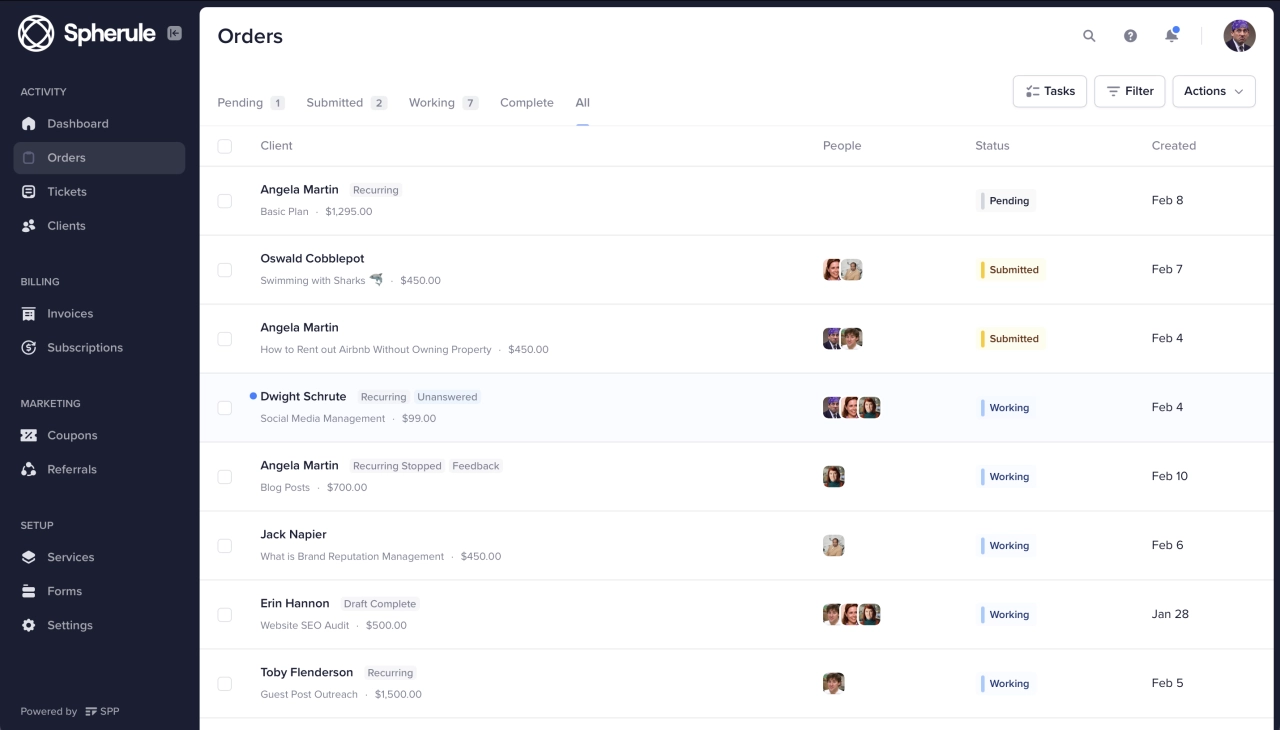Package Profitability for productized Agencies
Determine the true profitability of your standardized service packages
Package Details
Profitability Analysis
Direct Labor Costs
$1,250.00
Total Costs
$2,000.00
Real Profit
$500.00
Profit Margin
20.00%
Minimum Clients for Break-Even
2
(Based on fixed overhead & profit per package)
Frequently Asked Questions
- How does this calculator determine package profitability?
-
The calculator uses a comprehensive cost analysis approach:
- Calculates direct labor costs (hours × hourly rate)
- Adds all variable costs (software, PM overhead, acquisition costs)
- Subtracts total costs from package price to determine real profit
- Calculates profit margin as a percentage of package price
- Determines minimum clients needed to cover fixed overhead
This gives you a complete picture of your package's true profitability.
- What should I include in "Direct Labor Hours"?
-
Include all time spent directly working on the package deliverables:
- Actual production work (design, development, content creation)
- Research and analysis time
- Client communication and meetings
- Quality assurance and revisions
- Reporting and documentation
Don't include: General overhead, sales time, or administrative tasks (these go in other cost categories).
- How do I calculate the "Hourly Labor Rate"?
-
Your hourly labor rate should include all costs associated with your team:
- Base salary or contractor rate
- Benefits (health insurance, retirement, etc.)
- Employment taxes and workers' compensation
- Equipment and workspace costs per person
- Training and professional development
Formula: (Annual salary + benefits + taxes + equipment) ÷ billable hours per year
- What goes into "Software/Tools Allocation"?
-
Include the monthly cost of software and tools specifically used for this package:
- Industry-specific software licenses
- Stock photos, fonts, and creative assets
- Analytics and reporting tools
- Hosting and domain costs for client work
- API costs and third-party integrations
Tip: If you use the same tools across multiple packages, allocate costs proportionally based on usage.
- How do I determine "Project Management Overhead"?
-
Project management overhead includes coordination and administrative costs:
- Project manager time allocation
- Account management and client relations
- Status reporting and documentation
- Team coordination and planning meetings
- Quality assurance and final delivery
Rule of thumb: PM overhead typically ranges from 10-20% of direct labor costs for standardized packages.
- What is "Acquisition Cost Amortization"?
-
This represents the cost of acquiring each client, spread over their relationship duration:
- Sales and marketing expenses
- Proposal development time
- Discovery and onboarding costs
- Initial setup and configuration
Calculation: Total acquisition cost ÷ average client lifespan in months = monthly amortization
Example: $3,000 acquisition cost ÷ 12-month average client lifespan = $250/month
- How should I allocate "Fixed Overhead"?
-
Fixed overhead includes costs that don't vary with package volume:
- Office rent and utilities
- Insurance and legal fees
- Accounting and administrative costs
- General software subscriptions
- Owner/executive compensation
Allocation method: Divide total monthly overhead by the number of packages you can realistically deliver.
- What profit margin should I target for my packages?
-
Target profit margins vary by industry and business model:
- 20-30%: Minimum for sustainable operations
- 30-40%: Healthy margin for growth and reinvestment
- 40-50%: Strong margin for specialized packages
- 50%+: Premium pricing for highly specialized services
Remember: Higher margins allow for better team compensation, business growth, and market uncertainties.
- How do I interpret the "Minimum Clients for Break-Even"?
-
This metric shows how many package clients you need to cover your fixed overhead:
- Below this number, you're losing money on fixed costs
- At this number, you break even on overhead
- Above this number, you're profitable
Strategy tip: Aim to have 2-3x the break-even number of clients for healthy profitability and growth capacity.
- What if my package shows negative profitability?
-
If your package is unprofitable, consider these strategies:
- Increase package price: The most direct solution
- Reduce delivery time: Streamline processes and improve efficiency
- Lower labor costs: Optimize team structure or use junior resources
- Reduce scope: Remove or modify deliverables that aren't essential
- Negotiate better tool costs: Find more cost-effective software solutions
Remember: It's better to charge appropriately than to lose money on every sale.
- How often should I recalculate my package profitability?
-
Regular recalculation ensures your packages remain profitable:
- Monthly: Track actual vs. estimated hours
- Quarterly: Review and adjust all cost inputs
- Annually: Comprehensive review of pricing strategy
- When costs change: Update immediately for salary increases, new software, etc.
Pro tip: Track time meticulously for the first 3-6 months to validate your estimates.
- Can I use this calculator for different package variations?
-
Yes! Use this calculator to analyze different package options:
- Basic vs. Premium packages: Compare profitability across tiers
- Industry-specific variations: Adjust for different client types
- Seasonal packages: Account for fluctuating costs and demand
- Team size variations: Model different resource allocations
Best practice: Create separate calculations for each distinct package to optimize your entire portfolio.

You're in good company. We've helped agencies like yours sell $500M+ in services.


